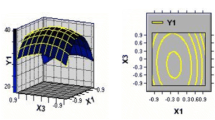Abstract
Harmful algal blooms (HABs) have led to extensive ecological and environmental issues and huge economic losses. Various HAB control techniques have been developed, and biological methods have been paid more attention. Algicidal bacteria is a general designation for bacteria which inhibit algal growth in a direct or indirect manner, and kill or damage the algal cells. A metabolite which is strongly toxic to the dinoflagellate Alexandrium tamarense was produced by strain DH46 of the alga-lysing bacterium Alteromonas sp. The culture conditions were optimized using a single-factor test method. Factors including carbon source, nitrogen source, temperature, initial pH value, rotational speed and salinity were studied. The results showed that the cultivation of the bacteria at 28°C and 180 r min−1 with initial pH 7 and 30 salt contcentration favored both the cell growth and the lysing effect of strain DH46. The optimal medium composition for strain DH46 was determined by means of uniform design experimentation, and the most important components influencing the cell density were tryptone, yeast extract, soluble starch, NaNO3 and MgSO4. When the following culture medium was used (tryptone 14.0g, yeast extract 1.63g, soluble starch 5.0 g, NaNO3 1.6 g, MgSO4 2.3 g in 1L), the largest bacterial dry weight (7.36 g L−1) was obtained, which was an enhancement of 107% compared to the initial medium; and the algal lysis rate was as high as 98.4% which increased nearly 10% after optimization.
Similar content being viewed by others
References
Anderson, D. M., Kulis, D. M., Qi, Y. Z., Zheng, L., Lu, S. H., and Lin, Y. T., 1996. Paralytic shellfish poisoning in southern China. Toxicon, 34(5): 579–590.
Bai, S. J., Huang, L. P., Su, J. Q., Tian, Y., and Zheng, T. L., 2011. Algicidal effects of a novel marine actinomycete on the toxic dinoflagellate Alexandrium tamarense. Current Microbiology, 62(6): 1774–1781.
Doucette, G. J., 1995. Interaction between bacteria and harmful algae: a review. Natural Toxins, 3: 65–74.
Doucette, G. J., Kodama, M., and Gallacher, S., 1998. Bacterial interaction with harmful algal bloom species: bloom ecology, toxigenesis and cytology. In: Physiological Ecology of Harmful Algal Bloom, Anderson, D. M., Cembella, A. D., and Hallegraeff, G. M. eds., NATO ASI Series, G41. Springer-Verlag Heidelberg, Berlin, 619–647.
Fang, K., 1994. Uniform design and Uniform Design Table. Science Publishing Company, Beijing, 161pp.
Guillard, R. R. L., 1975. Culture of phytoplankton for feeding marine invertebrates. In: Culture of Marine Invertebrate Animals. Smith, W. L., and Canley, M. H., eds., Plenum Press, New York, 29–60.
Lara, E. F., Link, H., and Botz, D. W., 2006. Evaluation of artificial neural networks for modelling and optimization of medium composition with a genetic algorithm. Process Biochemistry, 41: 2200–2206.
Sengco, M. R., and Anderson, D. M., 2004. Controlling harmful algal blooms through clay flocculation. Journal of Eukaryotic Microbiology, 51(2): 169–172.
Su, J. Q., Yang, X. R., Zhou, Y. Y., and Zheng, T. L., 2011. Marine bacteria antagonistic to the harmful algal bloom species Alexandrium tamarense (Dinophyceae). Biological Control, 56: 132–138.
Su, J. Q., Yang, X. R., Zheng, T. L., and Hong, H. S., 2007. An efficient method to obtain axenic cultures of Alexandrium tamarense-a PSP-producing dinoflagellate. Journal of Microbiology Methrod, 69(3): 425–430.
Su, J. Q., Yang, X. R., and Zheng, T. L., 2007. Isolation and characterization of a marine algicidal bacterium against the toxic dinoflagellate Alexandrium tamarense. Harmful Algae, 6(6): 799–810.
Tang, Q., and Feng, M., 1997. Practical Statistics and DPS Data Processing System. China Agriculture Press, Beijing, 407pp.
Tang, Q. Y., and Feng, M. K., 2007. Data analysis system: Experimental design, statistical analysis and data mining. Science Publishing Company, Beijing, 1140pp.
Tao, Y., Long, Z., Jin, H., Xie, J., Tao, K., Ran, H., Ge, S., Liu, K., and Liu, S., 2004. Optimization of fermentation condition of chitinase-producing bacterium C4 by uniform-design. Biotechnology, 14(6): 44–46.
Wang, B. X., Yang, X. R., Zhou, Y. Y., Lv, J. L., Su, J. Q., Tian, Y., Zhang, J., Lin, G. H., and Zheng, T. L., 2012. An algicidal protein produced by bacterium isolated from the Donghai Sea, China. Harmful Algae, 13: 83–88.
Wang, X., Li, Z. J., Su, J. Q., Tian, Y., Ning, X. R., Hong, H. S., and Zheng, T. L., 2010. Lysis of a red-tide causing alga, Alexandrium tamarense, caused by bacteria from its phycosphere. Biological Control, 52: 123–130.
Wang, Z. W., and Liu, X. L., 2008. Medium optimization for antifungal active substances production from a newly isolated Paenibacillus sp. using response surface methodology. Bioresource Technology, 99: 8245–8251.
Wang, X. L., Gong, L. Y., and Liang, S. K., 2005. Algicidal activity of rhamnolipid biosurfactants produced by Pseudomonas aeruginosa. Harmful Algae, 4(2): 433–443.
Wei, P. L., Chen, J., and Lu, Y. H., 2010. High density cultivation of Dictyostelium discoideum in a rotating polyurethane foam-bed bioreactor. World Journal of Microbiology Biotechnollogy, 26: 111–1123.
Yang, L. Y., and Ma, G. S., 2009. The application of uniform design in experiment of microorganism fermentation. Journal of Taiyuan Normal University, 8(3): 23–25.
Yuan, Z. M., Zuo, B., Tan, S. Q., Tan, X. S., and Xiong, X. Y., 2009. Experimental design and analysis of the optimal fermentation medium based on uniform design and support vector regression. The Chinese Journal of Process Engineering, 9(1): 148–152.
Zhang, Q., 1995. On the comparison of orthogonal design and uniform design (I). Application of Statistics and Management, 14(1): 25–29.
Author information
Authors and Affiliations
Corresponding author
Additional information
These authors contributed equally to this work.
Rights and permissions
About this article
Cite this article
Lin, J., Zheng, W., Tian, Y. et al. Optimization of culture conditions and medium composition for the marine algicidal bacterium Alteromonas sp. DH46 by uniform design. J. Ocean Univ. China 12, 385–391 (2013). https://doi.org/10.1007/s11802-013-2153-5
Received:
Revised:
Accepted:
Published:
Issue Date:
DOI: https://doi.org/10.1007/s11802-013-2153-5




